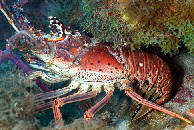
There are 300 to 500 million species of organisms in the ocean. Most of this life occurs along a relatively narrow strip formed by the continental shelves. These areas contain the world's most productive habitats: mangroves, salt marshes, mudflats, sea grass and seaweed beds, and coral reefs.
Marine organisms display a staggering variety of shapes and sizes, including the smallest of planktonic plants and animals to the largest animal on earth, the blue whale. Many people believe that the health of the world's oceans is directly tied to the quality of human life on earth. Certainly, from an economic perspective, the sea supports a world market that exceeds $20 billion, just from our natural resources. That figure is multiplied many times when we include shipping, mining, oil and gas extraction, and water recreation. Coastal communities are unique areas typically defined by businesses and activities that are associated with our oceans and natural resources. Fishing and SCUBA diving are two significant activities that often include harvesting marine life, either for commercial sale or for recreational and personal use. Businesses that support these activities range from dive shops, fishing tackle shops, net shops, fish dealers, seafood restaurants, and eco-tourism. The overall value of these businesses and activities exceed the economic value by influencing the flavor of communities and defining cultures that are unique across the U.S.